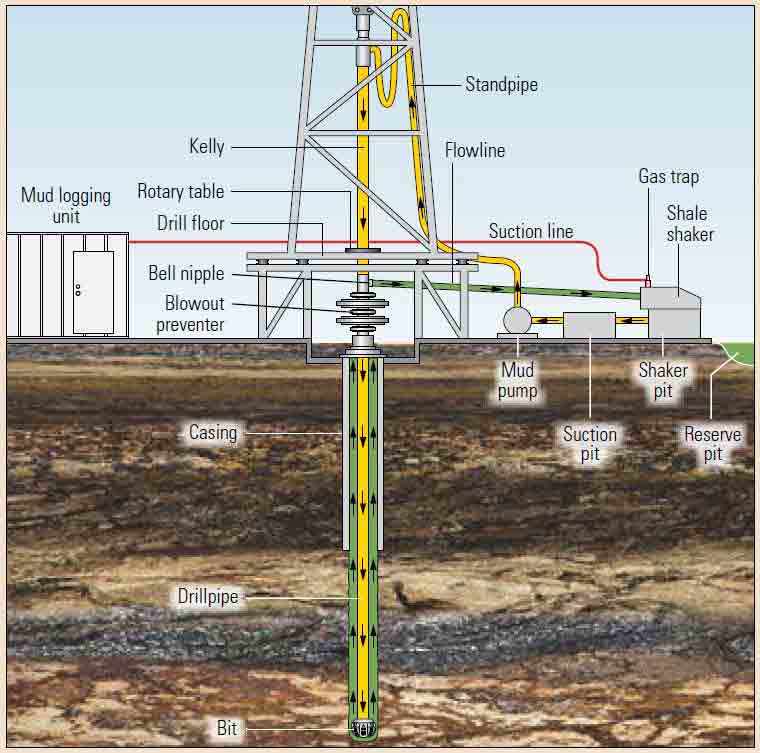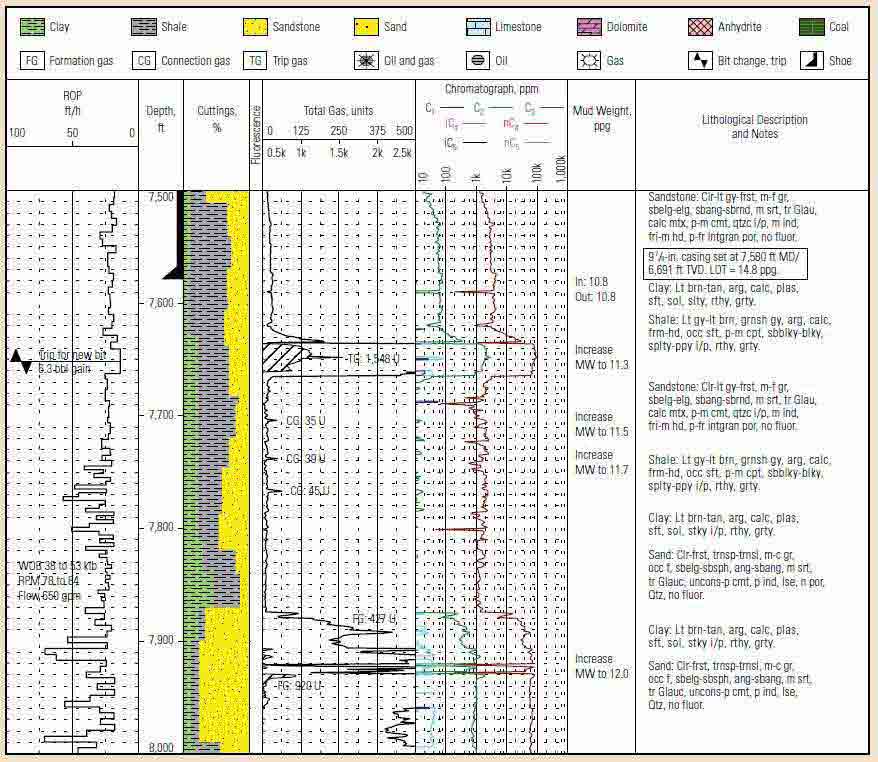Achieve rapid, cost-effective evaluation of the entire wellbore.
The Defining Series: Mud Logging
已发表: 11/11/2015

The Defining Series: Mud Logging
已发表: 11/11/2015

Since its commercial introduction in 1939, the mud logging unit has become a hub for monitoring formation responses to the drilling process. Initially, the mud logger's mandate was to record the depth and describe the lithology of formations encountered by the drill bit then determine whether those formations contained hydrocarbons. However, the scope of mud logging has expanded as additional sensors brought more data into the logging unit—such as gas chromatographs, weight-on-bit and mud pit level indicators. Basic mud logging services now typically track drilling rates, lithology, visual hydrocarbon indicators, total combustible gas in mud and individual hydrocarbon compounds in the gas along with numerous drilling parameters. The mud logger monitors and evaluates a broad range of surface indicators to compile a concise record of subsurface geology, hydrocarbons encountered and significant drilling events. These days, the term surface logging is sometimes used to encompass a range of enhanced mud logging services that incorporate advanced sensor and computing technology to provide monitoring for wellbore stability and early kick detection.
The practice of mud logging relies heavily on the mud circulation system. High-pressure mud pumps draw mud, or drilling fluid, from surface tanks and direct it downhole through the drillpipe (Figure 1). The mud exits the drillstring through nozzles in the bit. As a bit drills through the subsurface, the rock it grinds—along with water, oil or gas in the formation—is carried back up the hole by the drilling fluid. Upon reaching the surface, the fluid exits through a flowline above the blowout preventer and is deposited over a vibrating mesh screen at the shale shaker, which separates formation cuttings from the liquid mud. The liquid portion of the drilling fluid falls through the screens to the mud pits, ready to be pumped back into the well; the rock cuttings on the shaker screen provide the basis for determining downhole lithology.
Figure 1. Monitoring the formation. Drilling mud, pumped downhole through the center of the drillpipe, enters the open borehole and carries away formation cuttings and fluids as it moves upward to the surface. There, the mud, formation fluids and cuttings are diverted through a flowline to the shale shaker. Gas is separated from the mud, and a suction line siphons the gas to the mud logging unit for analysis. Cuttings are sampled at the shaker screen and examined inside the unit. When these evaluations are combined with drilling parameters—drill rate, pump rate, pump pressure, weight on bit, mud properties and other inputs—the mud logger can identify potential pay zones and ascertain how the formation is reacting to the drilling process.

Depth of Samples
The type of material flowing over the shaker and the timing of its arrival are fundamental to the mud logging process. To characterize the lithology and fluid content of a particular interval, the mud logger must account for the transport velocity of the cuttings to determine the time it takes cuttings to travel from the bit to the shaker. This lag time increases as depth increases, taking just a few minutes while the upper section of a well is drilled but extending to several hours in deeper sections. Lag time, a function of depth and mud pump rate, is usually measured in terms of pump strokes, which are counted by a pump stroke counter at the mud logger's console.
The lag time dictates when formation cuttings from a given depth will arrive at the shaker. Lagged cuttings samples are collected at regular depth intervals—typically every 3 m [10 ft] or 10 m [30 ft] of drilling—and prior to tripping out of the hole. Lagged samples are also collected to examine changes in formation characteristics, as indicated by significant changes in drill rate or gas curve trends.
Sample Analysis
Inside the logging unit, the mud logger rinses and dries cuttings samples before examining them under a binocular microscope. The mud logger describes each sample in terms of lithology, color, grain size, shape, sorting, porosity, texture and other characteristics relevant to rock type. This information is plotted in the lithology column of the mud log, which displays an estimate of gross lithology as a percentage of cuttings, reported in 10% increments. Because the presence of hydrocarbons may not be obvious—even under a microscope—each sample is examined for fluorescence under ultraviolet (UV) light.
Fluorescence can be an extremely sensitive indicator of the presence of hydrocarbons in drill cuttings. Sample fluorescence is evaluated in terms of color (ranging from brown to green, gold, blue, yellow or white), intensity and distribution. Fluorescence color may indicate oil gravity; dark colors are suggestive of low API gravity heavy oils, and light colors indicate high API gravity light oils. Following application of a solvent on the samples, hydrocarbon fluorescence will appear to flow and diffuse into the solvent as the oil dissolves. This diffusion is known as cut fluorescence, or more commonly just cut. Under UV light, hydrocarbons may be seen to stream from the rock pores into the surrounding solvent, turning the solvent cloudy.
To measure gas, the mud logger relies on an automated gas detection system. Suction lines transport a constant stream of air and gas from the gas trap, located at the shale shaker, to the logging unit. There, sensitive instruments process the gas samples extracted from the drilling mud. The primary gas measurement tool is a flame ionization detector (FID), which can sense hydrocarbon gas concentrations as low as 5 parts per million. From FID measurements, a total gas curve can be plotted on the mud log. Background gas—a more or less constant, minimum level of gas—establishes a baseline on the total gas plot. A gas show is any significant increase in detected gas, which is usually associated with a zone of increased porosity or permeability.
For more detailed hydrocarbon analysis during shows, the mud logger employs a gas chromatograph. The chromatograph separates the gas stream into fractions according to molecular weight. Commonly detected components fall within the alkane group: methane [CH4]—denoted as C1—as well as the following constituents: ethane [C2H6] or C2, propane [C3H8] or C3, the normal and isopolymers of butane [C4H10] or nC4 and iC4 and pentane [C5H12] or nC5 and iC5. The measurement of these light hydrocarbons helps geologists characterize reservoir fluid composition while drilling. The quantity of gas recovered and the ratios of the various gases are useful in identifying zones of producible oil or gas.
Coordination with the Drill Floor
Gas monitoring is also important to the driller and company representative. Mud gas trends that develop while drilling are integral to the evaluation of mud balance and identification of potentially overpressured formations. By carefully tracking gas and drilling parameters, the mud logger can recognize deviations from normal trends and give advanced warning so the driller can mitigate impending problems. Thus, the success of a well and the safety of the drilling operation may hinge on how quickly a mud logger can synthesize and interpret myriad pieces of data.
A sensor mounted on the drawworks tracks the drill rate, or rate of penetration (ROP), to determine the amount of time spent drilling each meter or foot of depth. The mud logger's role takes on added importance when a drilling break, or significant increase in ROP, is encountered. Then the mud logger alerts the company representative to request that drilling be stopped until mud and cuttings from the bit face can be circulated to the surface. If these cuttings are accompanied by an increase in gas, or if sample analysis reveals the presence of oil, the mud logger notifies the company representative and geologist of a show of gas or oil. The operator then has the option to further evaluate the potential pay zone through coring or testing.
The mud log serves a variety of functions (Figure 2). The ROP curve is plotted as a step chart or a continuous line, increasing from right to left. When displayed in this manner, the ROP curve responds to changes in rock type or porosity in a manner similar to that of a spontaneous potential or gamma ray curve, making for easy correlation between LWD or wireline curves. As a correlation tool, the mud log's ROP and total gas curves often exhibit a remark-able correspondence to gamma ray and resistivity curves, respectively. Throughout the drilling process, mud logs provide real-time correlations with logs from offset wells and help the operator track the bit's position in relation to target formations. Because the mud log is based on physical samples, it can provide a direct, positive identification of lithology and indication of hydrocarbon content. This information can be especially useful when formation characteristics make wireline or LWD log interpretation complicated or ambiguous. The mud log provides independent evidence for a more comprehensive understanding of reservoir conditions and geology.

Advances in computing and networking systems, surface sensor design and sample analysis are bringing mud logging technology into the 21st century. Today, even more sensors lead into the logging unit, each acquiring data at a frequency of several times per second. To handle this increase in data rate and volume, a context-aware processing system—based on computer-generated trend lines and a library of established models—makes the data easier for the mud logger and other end users to evaluate. Digital images of samples viewed under the microscope can be rapidly transmitted from the wellsite to the client office. New approaches to gas sampling and analysis have been developed to extract geochemical properties at the well-site. The mud logging unit has long been a hub for monitoring drilling operations; its role as a source of crucial information for the company representative, the driller and the geologist continues to evolve.
Oilfield Review 2015.
Copyright © 2015 Schlumberger.
